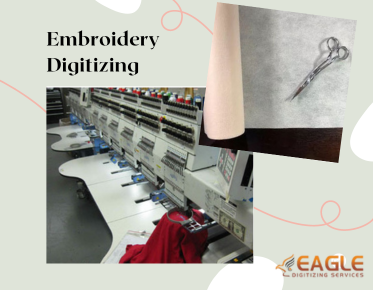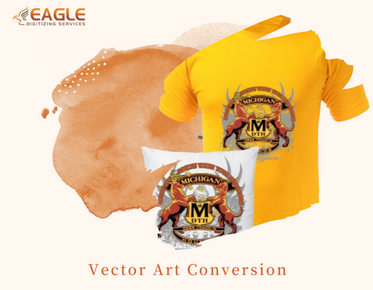Essential Materials for Silkscreen Printing Explained from Eagle digitizing
Silkscreen printing, also known as screen printing, is a versatile and popular method for creating vibrant and durable prints on various surfaces. Whether you're looking to design custom apparel, create art prints, or produce promotional materials, understanding the basic materials used in silkscreen printing is crucial. This guide will provide a comprehensive overview of the essential components and techniques to help you get started with confidence. If this post piqued your curiosity and you wish to learn more about online vector graphic services, feel free to reach out to us.
Screens and Mesh
Types of Screens: Wood vs. Aluminum Frames
Screens can be made with either wood or aluminum frames. Wood frames are cost-effective and easy to construct, while aluminum frames offer greater durability and maintain consistent tension over time.
Mesh Count: What It Means and Why It Matters
Mesh count refers to the number of threads per inch on the screen. Lower mesh counts (80-110) are suitable for printing on fabric with thick inks, while higher mesh counts (200-355) are ideal for detailed designs on smooth surfaces.
Choosing the Right Mesh for Your Project
Selecting the right mesh depends on your design and substrate. For intricate designs on paper, a high mesh count is necessary. For bold prints on fabric, a lower mesh count is preferable.
Emulsion and Coating
What is Emulsion?
An emulsion is a light-sensitive liquid that hardens when exposed to UV light, creating a stencil on the screen. This stencil allows ink to pass through specific areas while blocking others.
Types of Emulsion: Diazo, SBQ, and Dual Cure
● Diazo Emulsion: Affordable and versatile, suitable for beginners.
● SBQ Emulsion: Fast-curing and ideal for professional use.
● Dual Cure Emulsion: Combines the benefits of both, offering durability and ease of use.
How to Apply Emulsion to Screens
Apply emulsion evenly using a scoop coater in a dark room. Ensure a smooth, thin layer to avoid issues during exposure. Let the coated screen dry in a dark, dust-free environment.
Artwork and Transparencies
Creating Artwork for Silkscreen Printing
Your design should be created in a high-contrast format, preferably as a vector file. This ensures sharp edges and clear details when transferred to the screen.
Preparing Transparencies for Exposure
Print your design onto a transparency film using a high-resolution printer. The darker and more opaque the design, the better the exposure results.
Tips for Achieving Sharp and Clear Designs
Use high-quality transparency films and ensure your artwork is properly aligned and free from any dust or smudges. Proper exposure time is crucial for achieving sharp edges.
Exposure Unit
What is an Exposure Unit?
An exposure unit uses UV light to harden the emulsion on your screen, transferring your design from the transparency to the screen. It’s a critical component in the silkscreen printing process.
DIY Exposure Units vs. Professional Equipment
DIY exposure units can be made using UV bulbs and simple construction, suitable for small-scale projects. Professional exposure units offer consistent results and are ideal for larger operations.
Best Practices for Exposing Screens
Ensure the transparency is in full contact with the screen, and follow the manufacturer’s guidelines for exposure time. Consistent exposure ensures a clear, precise stencil.
Washout Booth
Importance of a Washout Booth
A washout booth is where the unexposed emulsion is washed away, leaving the design on the screen. It prevents emulsion residue from contaminating your workspace.
DIY vs. Commercial Washout Booths
DIY washout booths can be constructed using a garden hose and a simple enclosure. Commercial booths offer better drainage and lighting, making the process more efficient.
Tips for Effective Screen Cleaning
Use a high-pressure hose to wash out the unexposed emulsion. Ensure the screen is completely clean and free from residue before use.
Inks
Types of Silkscreen Inks: Plastisol, Water-Based, and Discharge
● Plastisol Inks: Durable and vibrant, perfect for fabric printing.
● Water-Based Inks: Eco-friendly and softer on fabrics, ideal for paper and lighter textiles.
● Discharge Inks: Remove dye from fabric, allowing for soft, vibrant prints on dark garments.
Specialty Inks: Metallic, Glitter, and Glow-in-the-Dark
Specialty inks add unique effects to your prints. Metallic and glitter inks create eye-catching designs, while glow-in-the-dark inks add a fun, luminous element.
How to Choose the Right Ink for Your Project
Consider your substrate and desired effect. Plastisol is great for bold prints on fabric, while water-based inks are better for eco-friendly projects. Specialty inks can enhance creative designs.
Squeegees
Understanding Squeegee Blades: Durometer and Shape
The durometer measures the hardness of the squeegee blade. Lower durometer (soft) blades are ideal for printing on fabric, while higher durometer (hard) blades are better for fine detail on smooth surfaces. Blade shapes, such as square, round, or V-shaped, affect ink application.
Choosing the Right Squeegee Handle
Handles come in various materials like wood, plastic, and aluminum. Choose a handle that offers comfort and control for extended use.
Techniques for Proper Squeegee Use
Apply even pressure and maintain a consistent angle. Practice smooth, fluid strokes to ensure even ink distribution.
Pallets and Printing Boards
Types of Pallets: Standard, Sleeve, and Specialty
Pallets hold your substrate in place during printing. Standard pallets are versatile, while sleeve pallets are designed for printing on sleeves and specialty pallets accommodate unique items like hats or bags.
Preparing and Maintaining Printing Boards
Ensure pallets are clean and smooth before use. Regular maintenance extends their lifespan and ensures consistent prints.
Tips for Consistent Prints
Secure the substrate firmly and use registration marks to align your design. Consistency in pressure and technique ensures uniform prints.
Drying and Curing
Importance of Proper Ink Curing
Proper curing ensures the ink adheres permanently to the substrate, preventing peeling or fading.
Different Methods: Air Drying, Heat Guns, and Conveyor Dryers
● Air Drying: Suitable for water-based inks but can be time-consuming.
● Heat Guns: Effective for small projects but require careful handling to avoid scorching.
● Conveyor Dryers: Ideal for large-scale production, offering consistent and efficient curing.
Tips for Ensuring Durability
Follow the manufacturer’s curing guidelines. Test cured prints by stretching the fabric to ensure the ink doesn’t crack or peel.
Cleaning Supplies
Essential Cleaning Chemicals and Solutions
Use specialized screen cleaners and degreasers to remove ink and emulsion. Avoid harsh chemicals that can damage screens and equipment.
Cleaning Screens, Squeegees, and Other Equipment
Thoroughly clean screens and squeegees after each use to prevent ink buildup. Regular maintenance keeps equipment in good working condition.
Environmentally Friendly Cleaning Practices
Opt for biodegradable cleaning solutions and properly dispose of chemical waste to minimize environmental impact.
Tape and Blockout
Using Tape for Clean Edges and Registration
Tape off areas of the screen not covered by emulsion to prevent ink from seeping through. Use registration tape to align multi-color prints.
Blockout Fluid for Screen Repairs
Blockout fluid covers pinholes or areas of the screen where the emulsion has worn away, preventing unwanted ink passage.
Tips for Effective Taping and Blocking
Apply tape smoothly and securely. Use blockout fluid sparingly and allow it to dry completely before printing.
Substrates
Common Substrates: Fabrics, Paper, and Plastics
Different substrates require different inks and techniques. Fabrics, paper, and plastics are common choices, each with unique properties and preparation needs.
Preparing Substrates for Printing
Ensure substrates are clean and dry. Pre-wash fabrics to remove sizing agents that can interfere with ink adhesion.
Tips for Printing on Unusual Surfaces
Experiment with different inks and techniques for unique surfaces. Test prints help refine your approach and ensure quality results.
Registration Tools
Importance of Registration in Silkscreen Printing
Accurate registration ensures the alignment of multiple colors and design elements, critical for professional-quality prints.
Using Registration Marks and Pins
Registration marks on your screens and substrate help align your design. Pins can secure substrates in place for consistent prints.
Tools and Techniques for Perfect Alignment
Registration systems, such as micro-registration clamps, provide precise adjustments. Practice and patience are key to mastering alignment.
Heat Press and Flash Dryers
What is a Heat Press and When to Use It?
A heat press applies heat and pressure to cure inks and set transfers. It’s useful for final curing and adding heat-applied designs.
Flash Dryers: How They Work and When to Use Them
Flash dryers quickly cure ink between color applications. They’re essential for multi-color designs and speeding up production.
Tips for Efficient Heat Press and Flash Dryer Use
Monitor temperature and time to avoid scorching. Ensure even heat distribution for consistent curing.
Stencils and Templates
Creating and Using Stencils
Stencils are cut-outs of your design used to block ink passage, creating the print. They can be made from various materials, including paper, plastic, and metal.
Benefits of Templates for Repetitive Designs
Templates help streamline the printing process, especially for repetitive designs. They ensure consistency and speed up production.
DIY vs. Professional Stencils
DIY stencils can be made using simple materials and cutting tools, while professional stencils offer precision and durability for complex designs.
Protective Gear
Safety in Silkscreen Printing: What You Need
Protective gear is essential for safe printing practices. It helps prevent exposure to harmful chemicals and reduces the risk of injury.
Essential Protective Gear: Gloves, Masks, and Aprons
Gloves protect your hands from ink and chemicals. Masks prevent inhalation of fumes, and aprons keep your clothing clean and safe from spills.
Tips for Safe Printing Practices
Always work in a well-ventilated area, wear appropriate protective gear, and follow safety guidelines for handling chemicals and equipment.
Storage Solutions
Storing Screens, Inks, and Other Materials
Proper storage extends the life of your screens, inks, and equipment. Store screens in a dry, dark place to prevent emulsion degradation. Keep inks tightly sealed to avoid drying out.
Organizing Your Workspace for Efficiency
An organized workspace improves efficiency and productivity. Use shelves, drawers, and containers to keep your materials and tools neatly arranged.
Long-Term Storage Tips for Equipment
Clean and dry equipment thoroughly before storage. Use protective covers and store them in a cool, dry place to prevent damage and deterioration.
Silkscreen printing is a rewarding and creative process, made even better with the right materials and techniques. Eagle Digitizing offers vector graphics conversion services. From selecting the proper screens and inks to mastering registration and curing, each step contributes to the final product. Remember, practice and patience are key. So, dive in, experiment, and enjoy the vibrant world of silkscreen printing!



